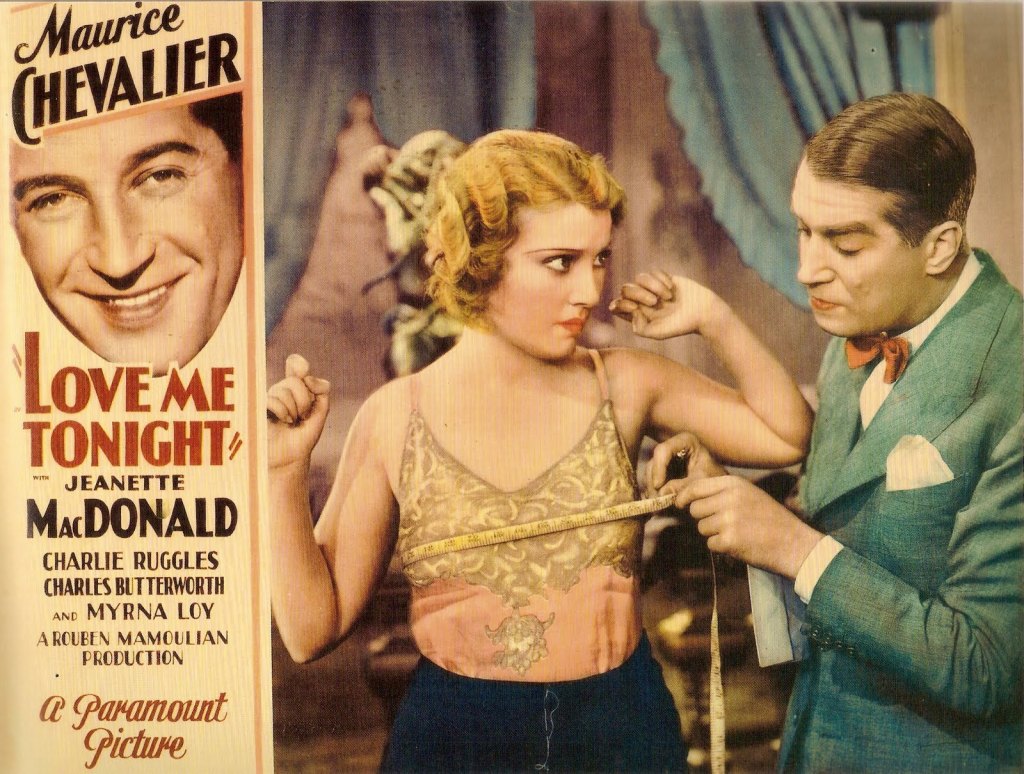
Dowager: Once upon a time there was a princess and a prince charming.
First Aunt: Who was not a prince.
Second Aunt: But who was charming.
Dowager: And they lived happily ever after.
—Love Me Tonight (1932)
Love Me Tonight (1932) is a charming early musical film, distributed by Paramount Pictures, that is a pre-Code romp through and through. Starring Maurice Chevalier and Jeanette MacDonald, the film cheekily and brightly tells the story of a tailor, disguising himself as a nobleman, who falls in love with a princess. While the key performers in the film are delightful, they are supported by a talented cast, including the likes of Charles Ruggles, C. Aubrey Smith, Charles Butterworth, and Myrna Loy. Moreover, the plot forges ahead to the tune of several beautiful song, including a show-stopping musical number that occurs a the very beginning of the film.
Initially, the plot surfaced as a 1931 French play entitled Le Tailleur au chateau or The Tailor at the Castle by Paul Armont and Leopold Marchand. The film was directed by Rouben Mamoulian and written by Samuel Hoffenstein, George Marion Jr., and Waldemar Young.
The full cast list for the film is as follows:
- Maurice Chevalier as Maurice, Baron Courtelin
- Jeanette MacDonald as Princesse Jeanette
- Charles Ruggles as Vicomte Gilbert de Varèze (as Charlie Ruggles)
- Charles Butterworth as Comte de Savignac
- Myrna Loy as Comtesse Valentine
- C. Aubrey Smith as the Duc d’Artelines
- Elizabeth Patterson as First Aunt
- Ethel Griffies as Second Aunt
- Blanche Friderici as Third Aunt (as Blanche Frederici)
- Joseph Cawthorn as Dr. Armand de Fontinac (as Joseph Cawthorne)
- Robert Greig as Major Domo Flammand
- Bert Roach as Émile
- George ‘Gabby’ Hayes as Grocer
Throughout the film, many of the comedic moments stem from Chevalier and his attempts to pass as a nobleman in an effort to pursue a romantic relationship with the MacDonald’s character. In addition to this fun dramatic irony for the audience to enjoy, the writing is also brimming with an assortment of pre-Code quips and double-meanings, including some of the following quotes:
Dr. Armand de Fontinac: A peach must be eaten, a drum must be beaten, and a woman needs something like that.
Princess Jeanette: Well, I was just about to go to bed.
Count de Savignac: Oh, wait, I’ll join you!
Princess Jeanette: What are you doing now?
Maurice Courtelin: I’m thinking. I’m thinking of you without these clothes.
Princess Jeanette: Open your eyes at once!
Maurice Courtelin: Oh no, pardon madam. With different clothes. Smart clothes.
Vicomte Gilbert de Vareze: He’s been chasing me.
Maurice Courtelin: Who?
Vicomte Gilbert de Vareze: The lady’s husband. He came home unexpectedly.
However, one of the key gems in the film is the brisk opening number. Chevalier initially sings the opening verses to “Isn’t it Romantic?” and the theme is gloriously passed on from person to person and scene to scene, passing on the message until the audience travels to its lovely heroine, dreamily closing the song on her balcony. Along the way, Victor Milner’s cinematography shines, particularly with some fine camera magic and movement while Chevalier sings in front of a mirror. Moreover, this happens to be the first film to use the zoom lens, displaying further innovative cinematic accomplishments.
Despite being a pre-Code film, various scenes and dialogue wound up being removed by local censors upon the film’s release. Once the code was in full effect, film censor Joseph Breen advised Paramount to avoid reissues of the film, feeling that it would be so severely edited that the story would be ruined entirely. Later communications from Breen would approve re-releases with specified deletions, including the removal of a sultry scene featuring Loy in a transparent nightgown. The post-1934 Production Code release of the film reduced the running time from 104 minutes to 96 minutes. The missing minutes are presumed lost.
As the question of the “appropriateness” of certain costumes in the film was revisited during the Code, the actresses donning the costumes faced some contention themselves. Initially, Loy’s character was slated to wear a white empire-waist costume for the film’s party sequence; however, MacDonald insisted on wearing the gown. As a result, Loy revisited the costume department and worked to create a new design in black, offering a design that would certainly compete with MacDonald’s on the screen.
Overall, Love Me Tonight is a pre-Code confection that is a joy to revisit. Unfortunately, it is a film that is not often discussed and is frequently overlooked. To fans of early musicals and pre-Code films, this is a classic that is definitely worth viewing.

















Sounds smashing! Mamoulian remains a vastly underappreciated director. Is your review from the 2003 Kino DVD version? I read somewhere that that release was an 89-minute version, or did you see the 96-minute film? Tragic that the missing footage appears forever lost — we can always hope some foreign print can make this pre-Code classic whole again. Thanks for the review! — Dan O